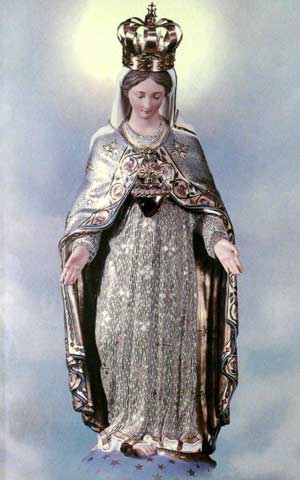 The statue of Our Lady of the Cape, seen on the opposite picture, was given to the Shrine of Cap-de-la-Madeleine, Que., in 1854, the same year as the proclamation of the dogma of the Immaculate Conception. We therefore celebrate in 2004 the 150th Anniversary of both events. This very same statue is still venerated in the Shrine today.
The statue of Our Lady of the Cape, seen on the opposite picture, was given to the Shrine of Cap-de-la-Madeleine, Que., in 1854, the same year as the proclamation of the dogma of the Immaculate Conception. We therefore celebrate in 2004 the 150th Anniversary of both events. This very same statue is still venerated in the Shrine today.
The shrine of Our Lady of the Cape or Notre-Dame-du-Cap is located on the St. Lawrence River in the town of Cap-de-la-Madeleine (Quebec), halfway between Montreal and Quebec City. It is one of Canada’s most visited shrines, since it is dedicated to Our Lady of the Rosary, Queen of Canada. The history of this shrine shows that when the faithful abandon the practice of the Rosary, everything collapses in families and society. As Pope John Paul II says, we must return to the practice of the daily recitation of the Rosary in the families, for the survival of peoples and nations.
French explorer Jacques Cartier, sailing the majestic St. Lawrence River, in 1535, had planted the Cross of Christ on one of the islands of the St. Maurice River, that separates the present cities of Trois-Rivieres (Three Rivers) and Cap-de-la-Madeleine. This was on October 7, which was to be proclaimed a few years later, by Pope Piux V, the Feast of the Holy Rosary.
Master Jacques de la Ferté, a priest of St. Marie Madeleine of Chateaudun, in France, and a member of the Company of the One Hundred Asssociates, received a plot called the Cape of Trois-Rivieres. In 1651, Master de la Ferté gave to the Jesuit Fathers, the first missionaries in the area, a domain, asking them to establish there a center of missions for the native peoples who went there every year to trade furs. In remembrance of the first owner, the Jesuits called the place Cap-de-la-Madeleine.
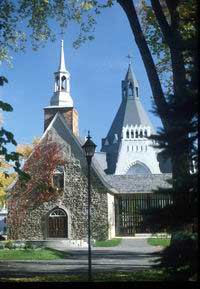 The small stone church, built in 1720, still exists today. It is the oldest church preserved in its integrity in Canada. In the back, the new Basilica of Our Lady of the Rosary, built in 1964. The small stone church, built in 1720, still exists today. It is the oldest church preserved in its integrity in Canada. In the back, the new Basilica of Our Lady of the Rosary, built in 1964. |
In the first years, this land was blessed with the passage of Fathers Brebeuf, Daniel, and Lalemant — three of the eight North American martyrs, canonized in 1930. For 18 years, Father Jacques Buteux was the main apostle of this settlement, and was martyred there by the Iroquois in 1652.
In 1659, a modest wooden chapel was erected by the governor of Trois-Rivieres, Pierre Boucher. It was given in 1661 to the new parish of St. Mary Magdalene, which inaugurated the devotion to Our Lady.
Cap-de-la-Madeleine was created a parish on October 30, 1867 by Blessed François de Laval, the first Bishop of Quebec City. In 1694, a Confraternity of the Rosary is established in the parish. Bishop de Saint-Vallier, the successor of François de Laval, wanted to replace the wooden parish church with a stone church, but the parishioners had to ask the financial aid of the other settlements in Canada at that time: Quebec City, Ville Marie (Montreal), and Trois-Rivieres. Our Lady was already establishing the foundations of a national shrine.
The “birth certificate” of the Shrine of the Queen of the Most Holy Rosary is signed on May 13, 1714, by Bishop of Saint-Vallier, of Quebec City. It is open to the cult in 1720, and as of today, 2004, is the oldest church in Canada that has retained its primitive state.
Flourishing at its beginning, the Confraternity of the Rosary experienced serious flagging one century later, due to the lack of zeal of a priest. The recitation of the Rosary was abandoned, and the parishioners did not even go to Mass on Sundays. Deprived of his Protectress and of zealous pastors, the morals of the population declines, as history has shown in every country.
 The statue of Our Lady of the Cape on the altar of the small stone church The statue of Our Lady of the Cape on the altar of the small stone church |
In 1854, the year of the proclamation of the Dogma of the Immaculate Conception of the Virgin Mary, Our Lady inspires Zephirin Dorval, a generous parishioner of Cap-de-la-Madeleine, to donate to the shrine a statue of the Madonna as She appeared to Catherine Laboure in 1830. This event is known as the Miraculous Medal Apparition. It shows Mary without the Child Jesus, Her arms outstretched toward the people, standing on a half-globe, Her foot/heal crushing the head of the snake. (cf Gen 3:15.) It is one of eleven identical statues made in Canada by an unknown Italian sculptor. The meaning of the burning heart of Mary is one of burning love beating in union with the heart of Her son, and partaking in His suffering.
The other characteristic element of the statue of Our Lady of the Cape is Her crown. As we will see later, it was added in 1904 to commemorate the 50th Anniversary of the definition of the Immaculate Conception. The coronation honors and highlights, in particular, the miraculous character of the statue. In fact, since the ice-bridge miracle of 1878, and the prodigy of the eyes of 1888, this statue of Our Lady has been considered miraculous.
The task of the new priest, Luc Désilets, was to arouse the languid faith of his parishioners, who had been without a parish priest for more than a century. When he arrived, the population of Cap-de-la-Madeleine was about one-thousand strong. One day, something strange attracted Father Désilets' attention. He was returning from the sacristy, where he had been hearing confessions, and stopped in the church for a moment to pray. It was the eve of the Feast of the Ascension, in 1867, but the church was empty. Suddenly, the priest was astonished to see a pig with a Rosary between its teeth. The thought came to him unbidden: “The Rosary falls from men's hands to be picked up by the swine.” It was subsequent to this curious incident that Father Désilets decided to propagate the devotion to the Rosary, and he dedicated himself to Our Lady of the Rosary on November 5, 1867.
Gradually, enthusiasm began to awaken; and the drowsy faith shook off its lethargy. The Rosary Society enjoyed renewed popularity, and the tiny 1714 church, which could barely hold a congregation of 60, became too small for the parish. People began to talk of a new church, the third in the history of the parish. Unfortunately, money was scarce; as for building stone, it was only to be found on the opposite shore of the St. Lawrence River. Nonetheless, the project of a new church was approved by the church wardens in the fall of 1878. The stone was cut and dressed on the south shore, ready to be carted over the frozen river once winter set in. But the winter of 1878-79 was temperate... and the parish could not afford the luxury of having the stone ferried across the waters.
The wardens wanted to demolish the first church built in 1714 and use the stones to build the new church, but Father Desilets made this vow to the Virgin Mary: “If You grant us solid ice on the river by the Feast of St. Joseph, we will not destroy Your small church, and we will dedicate it to Your Holy Rosary.”
Father Desilets' prayer was granted right away. Here is the testimony of Father Duguay, the curate and assistant of Father Desilets:
“On March 14, a high wind broke up the ice blocking the mouth of the St. Maurice River and fringing the northern shore of the St. Lawrence. The broken ice drifted downstream into the bay of Cap-de-la-Madeleine, covering the river to a distance of several hundred feet below the church. During Mass, I announced, on the parish priest's behalf, that there would be a High Mass on the 19th to petition St. Joseph for a bridge of ice. I added that, after vespers, I would accompany those who wished to prospect a passage to the far shore of the St. Lawrence River.
“When we reached the area where the river was covered, we saw that the drifting ice was scattered thinly amongst floating snow... We advanced onto the river, choosing places where the fragments of old ice seemed to be closer together. The distance between the broken-up floes varied considerably. On and on we went. Firmin Cadotte led the way, axe in hand, a rope around his waist, held by Flavien Bourassa... just in case!
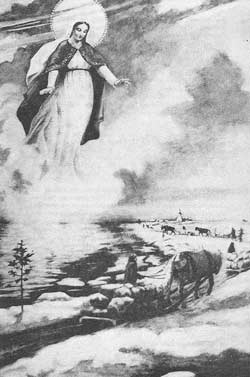 “From stopping place to stopping place, we made our way to the final floe of old ice. It must have been about 1,000 feet from the inshore ice along the southern shore... When I looked up, I saw that my two guides had moved on about 200 feet: they had realized that if they went upriver, diagonally, they might be able to reach the inshore ice which stretched out from the St. Angèle strand. Still moving forward, Firmin Cadotte struck through the thin ice with the head of his axe. The other men watched us go on, but did not dare follow, so that, in the end, my two guides and myself were the only ones to reach the south shore...
“From stopping place to stopping place, we made our way to the final floe of old ice. It must have been about 1,000 feet from the inshore ice along the southern shore... When I looked up, I saw that my two guides had moved on about 200 feet: they had realized that if they went upriver, diagonally, they might be able to reach the inshore ice which stretched out from the St. Angèle strand. Still moving forward, Firmin Cadotte struck through the thin ice with the head of his axe. The other men watched us go on, but did not dare follow, so that, in the end, my two guides and myself were the only ones to reach the south shore...
“Firmin Cadotte was crawling forward, feeling with his hand for a small strip or patch of ice which would take the weight of his knee... Thirty men worked along this 1,600-foot stretch until 11 o'clock that night, with only three lanterns to give light in their task, which was to prepare a track wide enough for two carts to pass each other. We came back at 11 p.m. Stopping next to the old sacristy I asked the men: ‘Well, what's the next step?’ Firmin Cadotte answered: ‘We have to pour water over the bridge in order to make it thicker.’ At 3 a.m. the same night, we were back at work on the ice. The night was crisp, considering it was the end of March, and the bridge was already solid enough to walk on.
“On March 18, at 4 a.m., the north wind had blown up and driven the clouds away. We sent off for some men to pour more water over our bridge and to saturate the snow which had fallen during the night. We were beginning to be proud of our bridge. When we tested it with a blow from an axe, we found that it was already six inches thick. This raised everyone's hopes of success. We had instructed Joe Bellefeuille and his son to prepare six-foot blocks of stone. While we were deciding where to open up the track (there had been a great deal of snow overnight), we saw the first sleigh coming over our bridge. It was driven by Joe Longval who had been eager to bring over the first load of stones.
“The working party, which had begun on Wednesday the 19th, lasted until the following Wednesday evening... By Sunday, 175 sleighs had crossed the river... We had transported about a thousand feet of dressed stone, plus stone for the foundations. I ordered a stop to the work, and no one undertook to make another voyage. It was quite extraordinary, a true miracle. It defied common sense. We immediately named it the Rosary Bridge." (By the way, 2004 marks the 125th Anniversary of this “Rosary Bridge”.)
In 1924, in remembrance of this miraculous event, the Oblates of Mary Immaculate, now in charge of the Shrine of Our Lady of the Cape, built the “Rosary Bridge”. On August 15 of the same year, Bishop Cloutier blessed it solemnly, and said to the crowd: “When one considers the way the ice bridge was formed at a time when everything seemed desperate, the loads it supported, and especially the growth of the pilgrimage since that time, should we not attribute it to a supernatural intervention? It is the Lord who made it.”
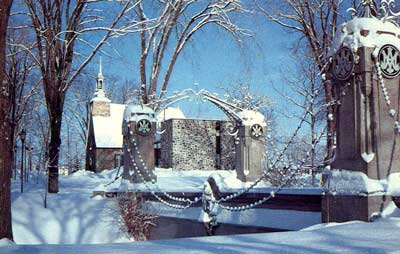
The Rosary Bridge built in 1924, in remembrance of the miracle of 1879
The miracle of the Rosary Bridge in 1879 therefore asserts in a striking way the presence of Mary at the Shrine of Cap-de-la-Madeleine. If there are still any doubts about it, they will disappear in 1888, with another prodigy taking place.
The new parish church of Cap-de-la-Madeleine is officially open to the cult on October 3, 1880, and in the following years, the old small church is restored to be dedicated to Our Lady of the Rosary, as Father Desilets had promised. On June 22, 1888, the small church is officially consecrated to Mary, and thus becomes the "Shrine". Father Frederic Janssoone, a Franciscan, delivers the appropriate sermon. He will become the first director of pilgrimages until 1902.
 After Mass, the statue was taken from the side altar and placed on the high altar, where it has remained ever since. Henceforth, the ancient parish church of Sainte-Marie-Madeleine was to be the official Notre-Dame-du-Cap Shrine. By this gesture, thanks were finally rendered for the extraordinary event of the ice bridge. At the end of this day of joy and prayer, the pilgrims went their way. Nothing out of the ordinary had marked the ceremonies... but the day had not yet drawn to its close. In the evening, a handicapped man named Pierre Lacroix arrived at the rectory. Fathers Désilets and Frederic conducted him to the Shrine to pray before the statue. It was then that the "marvel of the eyes" took place. Here is the testimony of Father Frederic, which was published on May 22, 1897 on the front page of the Montreal daily La Presse:
After Mass, the statue was taken from the side altar and placed on the high altar, where it has remained ever since. Henceforth, the ancient parish church of Sainte-Marie-Madeleine was to be the official Notre-Dame-du-Cap Shrine. By this gesture, thanks were finally rendered for the extraordinary event of the ice bridge. At the end of this day of joy and prayer, the pilgrims went their way. Nothing out of the ordinary had marked the ceremonies... but the day had not yet drawn to its close. In the evening, a handicapped man named Pierre Lacroix arrived at the rectory. Fathers Désilets and Frederic conducted him to the Shrine to pray before the statue. It was then that the "marvel of the eyes" took place. Here is the testimony of Father Frederic, which was published on May 22, 1897 on the front page of the Montreal daily La Presse:
“The statue of the Virgin had been sculptured with the eyes cast down. Now they were wide open, staring. The Virgin was looking straight ahead, Her eyes level. It could hardly be an optical illusion: Her face was clearly visible, illuminated by the sun which, shining through one of the windows, filled the whole shrine with light. Her eyes were black, well shaped, and in perfect harmony with the rest of Her face. The Virgin's expression was that of a living person, at once stern and sad. This marvel lasted somewhere between five and ten minutes.”
And now, the testimony of Pierre Lacroix: “I went into the shrine at about seven o'clock in the evening. I was with Father Luc Désilets and Father Frederic... Well, I was praying, and then I took a look at the Holy Virgin, just in front of me. I could see clearly that the statue's eyes were wide open, but it looked natural, as if She was staring over our heads...I didn't say a word, just went on looking at the statue, when Father Désilets got up — he was on my right — and went over to Father Frederic. I heard him say: ‘Do you see it?’ — ‘Yes,’ Father Frederic answered, ‘the statue has opened its eyes, hasn't it?’ — ‘Yes, it has. But is this really taking place?’ So I said that I'd seen the same thing, that I'd been watching it for several minutes. And I'm making this solemn declaration because I believe in my heart and conscience that it is true, and I know that it has the same force and binding effect as if it had been made under oath.”
Father Frederic died on August 4, 1916. One century after the “prodigy of the eyes,” he was beatified in Rome by Pope John Paul II on September 25, 1988.
After having commanded winds and water, snow and ice, so that a shrine could be built in Her honor, Our Lady of the Cape showed Her appreciation for having been installed in Her shrine under the title of Our Lady of the Rosary. For Father Desilets, these wide-open eyes of the Madonna meant something special, like what God had said in the past to King Solomon:
“I have heard thy prayer and thy supplication, which thou hast made before me: I have sanctified this house, which thou hast built, to put my name there for ever, and my eyes and my heart shall be there always.” (1 Kings 9:3.)
On June 22, 1888, at 7 o'clock, Our Lady of the Cape became, through the express will of Mary, the Madonna of the Canadians. On that day, Father Frederic stated:
“Pilgrims will come from all the families of the parish, from all the parishes of the diocese, and from all the dioceses of Canada. This small house of God will become too small to contain the crowds that will come to invoke the power and munificence of the sweet Queen of the Most Holy Rosary.”
In 1898, 500 members of the Third Franciscan Order of the Immaculate Conception of Montreal donate to Our Lady of the Cape, on behalf of their Irish fellow countrymen, a magnificent golden heart and a rich crown. The heart and crown will become inseparable, since they mean that Mary is both Mother and Queen. The heart is pierced by a sword, and topped by a lily, representing the Sorrowful and Immaculate Heart of Mary.
The crown will be used in 1904 for the solemn crowning of the statue of Our Lady of the Cape, proclaimed officially by the Church as the Madonna of the Canadians.
The symbolic worth of this crown, made of gold, platinum, and diamonds from thousands of jewels offered by the Canadians, is infinitely superior to its material worth. The coats of arms of the ten Canadian provinces are displayed around the base, and proclaim Our Lady of the Cape as the patron saint and Protectress of all Canadians.
It is Bishop Cloutier of Trois-Rivieres who crowned the statue in 1904. He officially declared as a miracle the “Rosary bridge” of 1879, and recognized the supernatural character of the prodigy of the eyes of 1888. He then entrusted the care of the shrine to the Oblate Fathers of Mary Immaculate.
The 50th Anniversary of the proclamation of the dogma of the Immaculate Conception creates an atmosphere of extraordinary Marian enthusiasm in the whole Catholic world. In Canada, Catholics are overjoyed when they learn that the Pope has decided to crown Our Lady of the Cape.
The coronation of a statue is highly significant. Through this gesture, the Vicar of Christ puts the seal of his apostolic authority on the cult given to this statue, the miracles attributed to it, and the fame and glory that surrounds it. In America, only the statue of Our Lady of Guadalupe had received such an honor so far.
The day before the coronation, the Apostolic Delegate, Archbishop Sbarretti, presided over the candle procession. The next day, he celebrated Holy Mass, accompanied by representatives of all the Canadian Episcopate. Archbishops Duhamel of Ottawa and Begin of Quebec City praised, in English and in French, the glories of Our Lady of the Cape.
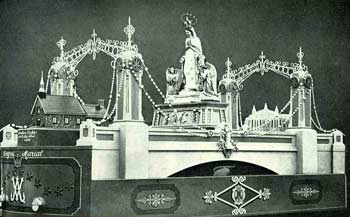 The Shrine of Cap-de-la-Madeleine had never seen such a big crowd. Then Bishop Cloutier, dressed in pontifical garments, moves to the statue, accompanied by Father Frederic, who carries the crown on a silken cushion. The Bishop blesses the crown, takes it and, on behalf of Pope Pius X, puts it on the head of Our Lady of the Cape. At the same moment, salvoes and bells resound, and the crowd is cheering. By a decree of the Pope, Our Lady of the Cape has become the Queen of Canada, the national Madonna of the Canadians.
The Shrine of Cap-de-la-Madeleine had never seen such a big crowd. Then Bishop Cloutier, dressed in pontifical garments, moves to the statue, accompanied by Father Frederic, who carries the crown on a silken cushion. The Bishop blesses the crown, takes it and, on behalf of Pope Pius X, puts it on the head of Our Lady of the Cape. At the same moment, salvoes and bells resound, and the crowd is cheering. By a decree of the Pope, Our Lady of the Cape has become the Queen of Canada, the national Madonna of the Canadians.
For the next 50 years, the Queen of the Rosary continues to attract ever-larger crowds. The peak of the pilgrimage season is on August 15, for the Feast of the Assumption. In 1947, there is a triumphal tour of the pilgrim statue of Our Lady around Canada. The faithful see the lily on the heart of the statue, begin to understand the devotion to the Immaculate Heart of Mary, and enthusiastically consecrate themselves to Her.
During the sejourn of the statue of Our Lady of the Cape in Ottawa in 1947, over one million Canadians recited with fervour the prayer of Pope Pius XII consecrating mankind to the Immaculate Heart of Mary, signed the consecration and put it at the feet of the Madonna. The heart of Our Lady of the Cape teaches us the most beautiful love from the most beautiful heart: that of our Heavenly Mother.
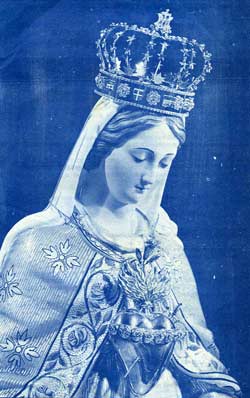 The statue crowned in 1954 The statue crowned in 1954 |
In 1954, the Marian Year is celebrated with fervour all over Canada, and reaches its apotheosis at the Shrine of Our Lady of the Cape, where the whole nation gathered at the feet of the Queen of the Rosary. The centenary of the definition of the Immaculate Conception coincided with the golden jubilee of the coronation of Our Lady of the Cape in 1904.
The Oblates of Mary Immaculate prepared for a long time in advance the celebrations of this glorious anniversary. Bishop Georges-Leon Pelletier of Trois-Rivieres even managed to obtain from Rome, for this occasion, a new crowning of the statue of Our Lady of the Cape, the coming of a papal legate, and a radio message from the Pope himself to the Canadian people.
In an unanimous voice, all the Bishops of Canada, from Newfoundland to British Columbia, confirmed their presence for this imposing ceremony at the Shrine of Cap-de-la-Madeleine on August 15, 1954. During the ten days preceding the Feast of the Assumption, each of the ten Canadian provinces had a special day of celebration at the Shrine, at the feet of the statue of our national Madonna.
On the eve of the feast, there were 200 priests to hear confessions at the shrine. On August 15, the procession is led by the papal legate, Cardinal Vallerio Valeri, followed by all the Canadian Bishops. At the end of the Mass, Cardinal Valeri gives the apostolic blessing to all the faithful present, accompanied with a plenary indulgence, through a privilege of the Holy Father.
The organizers of this unforgettable day had the idea of a parade of floats before the coronation ceremony. The floats represented the local or national Marian events in Canadian history. The local newspapers mentioned that “no one could remember such a demonstration in Trois-Rivieres.”
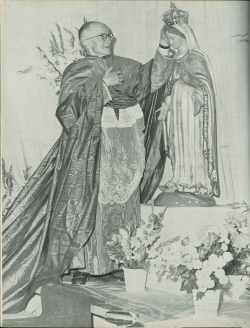 Cardinal Valeri crowns the statue Cardinal Valeri crowns the statue |
The coronation ceremony took place in the Trois-Rivieres' Exposition Park. The white throne on which the statue was placed was surrounded by a 35-foot arch with the words “Fulgens Corona” (in Latin, “radiant crown,” the name of the encyclical of Pope Pius XII proclaiming the Marian Year) and “A mari usque ad mare” (From coast to coast), the motto of Canada and of the Marian Congress. The procession with the floats and representatives of parishes lasted two hours. After the coronation of the statue by Cardinal Valeri, Cardinals Leger of Montreal and McGuigan of Toronto read, in Canada's two official languages, the act of consecration of our nation to the Immaculate Heart of Mary.
Then, by order of seniority, all the Bishops of Canada came in front of the statue to present their croziers. The two Canadian Cardinals then gave a speech on the social and spiritual scope of the devotion to Mary. The last word was reserved to Cardinal Valeri, the papal legate, who exhorted all to remain loyal servants of Mary, and expressed his best wishes for the salvation and prosperity of our nation. Finally, the float carrying the statue of Our Lady returned to the Shrine of Cap-de-la-Madeleine.
On September 10, 1984, Pope John Paul II celebrated an outdoor Mass at the Shrine of Our Lady of the Cape, and said: “This Marian pilgrimage is an immense grace accorded to the Canadian people. May the river of the prayerful never run dry here.” May all Canadians return to the recitation of the family Rosary, so that the Church in Canada will recover its splendor and vitality of the past!
Comments (1)
Mary K Thompson
I have been trying to find a statue of Our Lady of the Cape for my home here in the USA,
Thank you dear Mother.& thank you for bringing her to the forefront of our our lives. - Mary K Thompson USA
reply